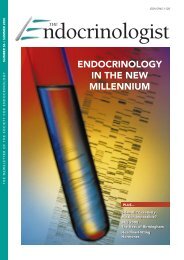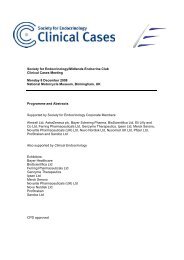Standards for undergraduate medical education - Society for ...
Standards for undergraduate medical education - Society for ...
Standards for undergraduate medical education - Society for ...
Create successful ePaper yourself
Turn your PDF publications into a flip-book with our unique Google optimized e-Paper software.
SOCIETY NEWS<br />
A VISION FOR THE FUTURE:<br />
COUNCIL APPROVES SOCIETY’S STRATEGIC REVIEW<br />
At its 24 January meeting, Council endorsed the latest <strong>Society</strong> strategic review. Usually a rolling 5-year process, the review<br />
scheduled <strong>for</strong> the end of 2010 was put on hold pending the appointment of the Chief Executive, Leon Heward-Mills. Here<br />
Leon outlines the latest review and the organisation’s ambitions <strong>for</strong> the next 3–5 years.<br />
To be a world-leading authority on hormones -<br />
that’s our over-arching ambition, and the goal that we<br />
will be aiming <strong>for</strong> towards 2020. But what does this<br />
mean, how do we measure it and, most importantly,<br />
what benefit will this demonstrate to members, to the<br />
broader <strong>medical</strong> and scientific community and to the<br />
public, the groups we exist to serve<br />
The measures used include specific monitoring against<br />
our core activities - publishing, advocacy etc, but also the<br />
efficacy of the <strong>Society</strong> BES meeting and our scientific and<br />
<strong>education</strong>al programmes. There are ‘softer’ qualitative<br />
measures as well, including member, potential member<br />
and public perception and feedback.<br />
Defining the vision<br />
Defining a strategic vision is straight<strong>for</strong>ward enough, but<br />
where organisations tend to fail is in strategy execution -<br />
delivering against the plan. Strategy should not be<br />
complicated: a clear and ambitious target and an agreed<br />
set of principles to follow to ensure that the goal is<br />
achieved. In the short term, the vision must be sufficiently<br />
unambiguous to allow the organisation to use it as a clear<br />
reference, aware of changing conditions over time.<br />
The process <strong>for</strong> defining the current plan began in<br />
October 2011 with a meeting of <strong>Society</strong> Officers, Chairs of<br />
the main <strong>Society</strong> committees and senior staff from the<br />
Bristol office. The outcome of that meeting was discussed<br />
and refined at subsequent committees, resulting in the<br />
plan put to Council in January.<br />
So at the top level is the ambition: our desire looking<br />
towards 2020 to be a world-leading authority on<br />
hormones. Taken in context, this should not compromise<br />
our relationship with other major national and<br />
international organisations. It will be the standard that we<br />
will measure ourselves against.<br />
Beneath this we have identified a series of ‘strategic<br />
initiatives’ - high level priority areas. Feeding into these are<br />
the projects that we have identified as necessary to ensure<br />
that the ambition is realised.<br />
Strategic initiatives<br />
At the heart of the plan is the strategic initiative to be a<br />
central gateway to hormone in<strong>for</strong>mation and knowledge<br />
resources. Adding value to membership but also increasing<br />
our significance to the public - in line with our charitable<br />
objective - by ensuring we are a trusted and valued source<br />
of in<strong>for</strong>mation and knowledge. Projects that will flow from<br />
this include development of a revised <strong>education</strong> strategy, a<br />
basic science support programme, a strategy to improve<br />
patient care and public awareness and the development of<br />
our publishing.<br />
To be a world-leading authority on hormones<br />
Stakeholder strategic initiatives<br />
Maximise appeal and value to<br />
members and potential members<br />
Develop an international presence<br />
outside Europe<br />
Advocate and lobby in support of<br />
endocrinology<br />
Collaborate with targeted<br />
societies/organisations<br />
Become a central gateway to<br />
hormone in<strong>for</strong>mation and<br />
knowledge resources<br />
Stakeholders<br />
Financial per<strong>for</strong>mance<br />
and stewardship<br />
Process and<br />
technology<br />
People, skills and<br />
knowledge<br />
Strategic initiatives – high priority areas that will ensure the <strong>Society</strong> delivers its strategic plan<br />
Another strategic initiative is the<br />
development of advocacy and<br />
lobbying in support of<br />
endocrinology, creating a clear<br />
plan, identifying our priorities and<br />
diverting resources as efficiently as<br />
possible. It is recognised that we<br />
will have greatest influence in the<br />
UK, but we will work with partners<br />
at a European or global level where<br />
appropriate.<br />
There are a range of strategic<br />
initiatives and over 25 short,<br />
medium and long term strategic<br />
projects, some that will deliver over<br />
the next 3 months, some stretching<br />
out towards 2015 and beyond, but<br />
all helping us work towards<br />
reaching our over-arching ambition.<br />
LEON HEWARD-MILLS<br />
The full strategic plan is<br />
on the <strong>Society</strong> website at<br />
www.endocrinology.org/strategy<br />
10 T H E E N D O C R I N O L O G I S T • I S S U E 1 0 3 • S P R I N G 2 0 1 2


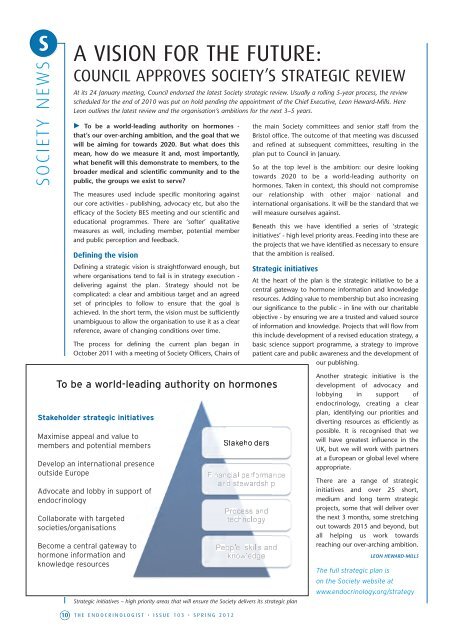
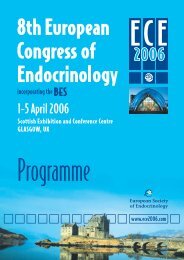
![The Endocrinologist | Issue 99 [PDF] - Society for Endocrinology](https://img.yumpu.com/48213777/1/184x260/the-endocrinologist-issue-99-pdf-society-for-endocrinology.jpg?quality=85)


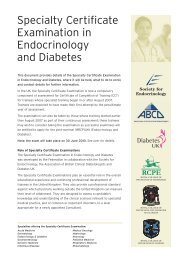
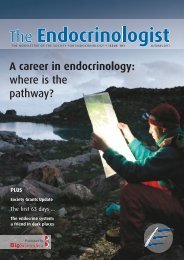
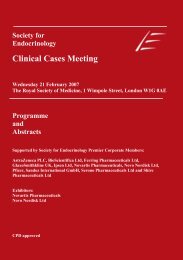

![The Endocrinologist | Issue 97 [PDF] - Society for Endocrinology](https://img.yumpu.com/40840065/1/184x260/the-endocrinologist-issue-97-pdf-society-for-endocrinology.jpg?quality=85)

